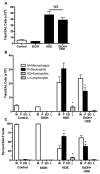Alcohol exposure alters mouse lung inflammation in response to inhaled dust
- PMID: 22852058
- PMCID: PMC3407989
- DOI: 10.3390/nu4070695
Alcohol exposure alters mouse lung inflammation in response to inhaled dust
Abstract
Alcohol exposure is associated with increased lung infections and decreased mucociliary clearance. Occupational workers exposed to dusts from concentrated animal feeding operations (CAFOs) are at risk for developing chronic inflammatory lung diseases. Agricultural worker co-exposure to alcohol and organic dust has been established, although little research has been conducted on the combination effects of alcohol and organic dusts on the lung. Previously, we have shown in a mouse model that exposure to hog dust extract (HDE) collected from a CAFO results in the activation of protein kinase C (PKC), elevated lavage fluid cytokines/chemokines including interleukin-6 (IL-6), and the development of significant lung pathology. Because alcohol blocks airway epithelial cell release of IL-6 in vitro, we hypothesized that alcohol exposure would alter mouse lung inflammatory responses to HDE. To test this hypothesis, C57BL/6 mice were fed 20% alcohol or water ad libitum for 6 weeks and treated with 12.5% HDE by intranasal inhalation method daily during the final three weeks. Bronchoalveolar lavage fluid (BALF), tracheas and lungs were collected. HDE stimulated a 2-4 fold increase in lung and tracheal PKCε (epsilon) activity in mice, but no such increase in PKCε activity was observed in dust-exposed mice fed alcohol. Similarly, alcohol-fed mice demonstrated significantly less IL-6 in lung lavage in response to dust than that observed in control mice instilled with HDE. TNFα levels were also inhibited in the alcohol and HDE-exposed mouse lung tissue as compared to the HDE only exposed group. HDE-induced lung inflammatory aggregates clearly present in the tissue from HDE only exposed animals were not visually detectable in the HDE/alcohol co-exposure group. Statistically significant weight reductions and 20% mortality were also observed in the mice co-exposed to HDE and alcohol. These data suggest that alcohol exposure depresses the ability of the lung to activate PKCε-dependent inflammatory pathways to environmental dust exposure. These data also define alcohol as an important co-exposure agent to consider in the study of inhalation injury responses.
Keywords: alcohol; inflammation; mortality; organic dust.
Figures








Similar articles
-
β2-Adrenergic agonists attenuate organic dust-induced lung inflammation.Am J Physiol Lung Cell Mol Physiol. 2016 Jul 1;311(1):L101-10. doi: 10.1152/ajplung.00125.2016. Epub 2016 May 17. Am J Physiol Lung Cell Mol Physiol. 2016. PMID: 27190062 Free PMC article.
-
Proteases in agricultural dust induce lung inflammation through PAR-1 and PAR-2 activation.Am J Physiol Lung Cell Mol Physiol. 2015 Aug 15;309(4):L388-99. doi: 10.1152/ajplung.00025.2015. Epub 2015 Jun 19. Am J Physiol Lung Cell Mol Physiol. 2015. PMID: 26092994 Free PMC article.
-
Insufficient zinc intake enhances lung inflammation in response to agricultural organic dust exposure.J Nutr Biochem. 2019 Aug;70:56-64. doi: 10.1016/j.jnutbio.2019.04.007. Epub 2019 May 3. J Nutr Biochem. 2019. PMID: 31153019 Free PMC article.
-
The Effect of Inhalant Organic Dust on Bone Health.Curr Allergy Asthma Rep. 2018 Feb 22;18(3):16. doi: 10.1007/s11882-018-0773-y. Curr Allergy Asthma Rep. 2018. PMID: 29470660 Free PMC article. Review.
-
Dust events, pulmonary diseases and immune system.Am J Clin Exp Immunol. 2014 Feb 27;3(1):20-9. eCollection 2014. Am J Clin Exp Immunol. 2014. PMID: 24660118 Free PMC article. Review.
Cited by
-
cAMP-dependent protein kinase activation decreases cytokine release in bronchial epithelial cells.Am J Physiol Lung Cell Mol Physiol. 2014 Oct 15;307(8):L643-51. doi: 10.1152/ajplung.00373.2013. Epub 2014 Aug 22. Am J Physiol Lung Cell Mol Physiol. 2014. PMID: 25150062 Free PMC article.
-
Asymmetric dimethylarginine blocks nitric oxide-mediated alcohol-stimulated cilia beating.Mediators Inflamm. 2013;2013:592892. doi: 10.1155/2013/592892. Epub 2013 Nov 6. Mediators Inflamm. 2013. PMID: 24307761 Free PMC article.
-
Dietary diallyl disulfide supplementation attenuates ethanol-mediated pulmonary vitamin D speciate depletion in C57Bl/6 mice.BMC Nutr. 2015;1:18. doi: 10.1186/s40795-015-0012-z. Epub 2015 Aug 25. BMC Nutr. 2015. PMID: 27536382 Free PMC article.
-
Dimethylarginine dimethylaminohydrolase (DDAH) overexpression enhances wound repair in airway epithelial cells exposed to agricultural organic dust.Inhal Toxicol. 2018 Feb;30(3):133-139. doi: 10.1080/08958378.2018.1474976. Epub 2018 May 25. Inhal Toxicol. 2018. PMID: 29793367 Free PMC article.
-
The alcohol exposome.Alcohol. 2025 Feb;122:81-89. doi: 10.1016/j.alcohol.2024.12.003. Epub 2024 Dec 23. Alcohol. 2025. PMID: 39722409 Free PMC article. Review.
References
Publication types
MeSH terms
Substances
Grants and funding
- R01 AA008769/AA/NIAAA NIH HHS/United States
- R01 AA017993/AA/NIAAA NIH HHS/United States
- U54OH010162-23509/OH/NIOSH CDC HHS/United States
- K08 AA019503/AA/NIAAA NIH HHS/United States
- I01 BX000728/BX/BLRD VA/United States
- R01 ES019325/ES/NIEHS NIH HHS/United States
- R37 AA008769/AA/NIAAA NIH HHS/United States
- R01ES019325/ES/NIEHS NIH HHS/United States
- R37AA008769/AA/NIAAA NIH HHS/United States
- R01AA017993/AA/NIAAA NIH HHS/United States
- R01OH008539/OH/NIOSH CDC HHS/United States
- R01 OH008539/OH/NIOSH CDC HHS/United States
- U54 OH010162/OH/NIOSH CDC HHS/United States
- R25 AA020818/AA/NIAAA NIH HHS/United States
LinkOut - more resources
Full Text Sources
Medical

